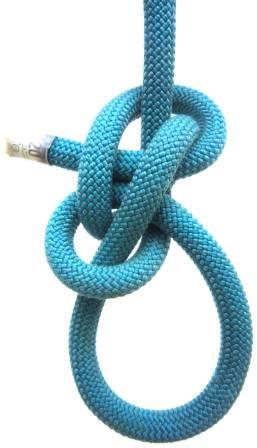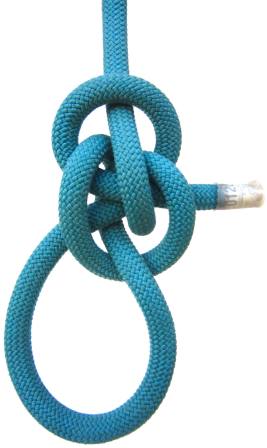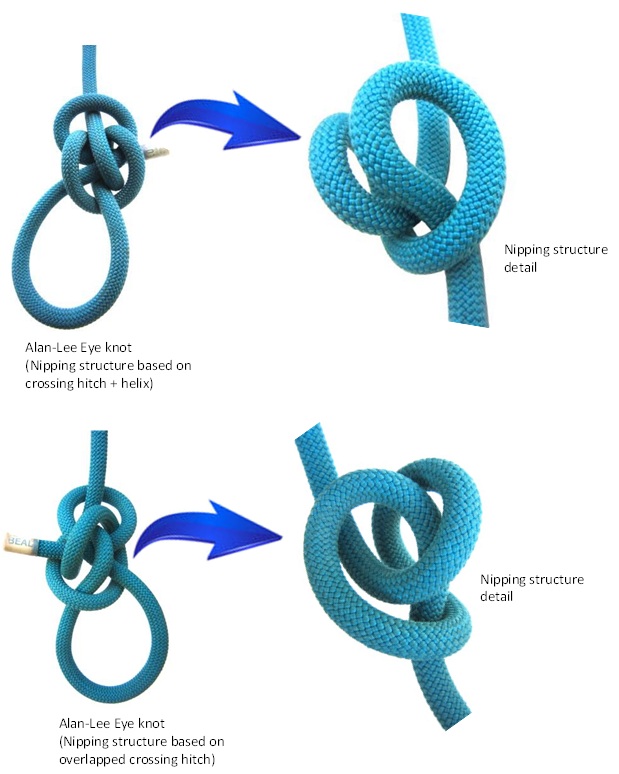To my view, NO overhand-knot-based bend ( or, for that matter, fig.8-knot-based bend ) turned into an eyeknot should be compared to the bowline, ever !
The links of (most) such bends “work” differently than the “nipping structure” of the bowline ( although they may work in the same way the “collar structure” of the bowline works ). Why ? Because, in a link of such a bend, we want to immobilise the penetrating line of the other link as much as we can, WITHOUT the help of a collar, and for that we use links ( overhand knots or fig.8 knots ) that are as tightly “closed” around themselves as possible. In the bowline, the “nipping structure” has only to immobilize the second leg of the collar, not the first one. When the continuation of the returning eyeleg has made its U-turn around the Standing Part, the portion of the tensile forces which is able to reach to the second collar has already been reduced a lot, so the burden of immobilizing is also reduced. In the bowline, we do not need nipping structures as tightly closed around themselves as the overhand knot or the fig.8 knot - moreover, we do not want suck knots, because we want our eyeknot to be as easily untiable as possible.
Again, I will repeat that I am talking about the easiness of untiability after HEAVY loading - and I can not tell if in some applications ( rescue or climbing, for example ), such loadings happen. In boating and sailing, they do, very often, and that is why seamen use their “king of knots”, the bowline.
It is a very simple thing to turn any of the existing bends into an eyeknot ! However, it is a very difficult thing to find a bend that, when turned into a loop, will be easily untiable, and will be PET.
If one wants to tie and try the bends which are NOT based on overhand knots of on fig.8 knots, and so they will still have chances to be easily untiable even after really heavy loading, he can tie all the 25 A bends of Miles, and turn them to the 100 corresponding PET eyeknots. ( And tells me if he finds among them a TIB eyeknot that I had missed…  )
)
[ The members of “Climbers and Co.” company are kindly requested to skip the next/last paragraph - too much “keystroking” for their taste, and not enough brainstorming, to regenerate asphyxiated brain cells, I am afraid )
Personally, I am interested only in bowline-like eyeknots that are also TIB, for many reasons. If a knot tyer does not understand/feel the versatility and the conceptual beauty of a knot that can do anything another knot does, but it is also TIB, I can not help him, I am afraid : he will miss the practical advantage of a most useful and the mental pleasure of a most enjoyable aspect of knotting, but I guess he will manage to live without it.  I am only interested in knotting for nothing - if by this “nothing” we mean a particular application, a “purpose”, such as money-making, rope-joining, tie and shoelaces tying, etc. I am interested in knotting for the pure joy of being able to “knot” a rope into a “knot”, by tying it in-the-bight, and which knot, although it will remain topologically equivalent to the unknot, i.e., to the straight, unknotted line, will nevertheless be stable and secure - and this joy can not be overestimated.]
I am only interested in knotting for nothing - if by this “nothing” we mean a particular application, a “purpose”, such as money-making, rope-joining, tie and shoelaces tying, etc. I am interested in knotting for the pure joy of being able to “knot” a rope into a “knot”, by tying it in-the-bight, and which knot, although it will remain topologically equivalent to the unknot, i.e., to the straight, unknotted line, will nevertheless be stable and secure - and this joy can not be overestimated.]


